Fiery Flying Serpent
שָׂרָף מְעוֹפֵֽף
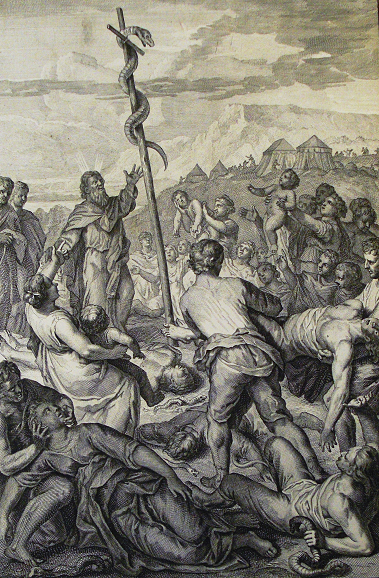
Moses raises the bronze serpent
as the Israelites get bit by the fiery serpents
1. Introduction
2.
Relevant Verses
3.
Etymology
4.
Is it a Seraphim?
5.
Fiery Serpent Revisited
6.
Historical Anecdotes
7.
Nehushtan
8.
Post Antiquity: Connection with Dragons
9.
The Ropen: Modern Day Pterosaur and other sightings
10.
Conclusion: what are these fiery flying serpents
11. External Links
The mysterious fiery flying serpent mentioned in the Bible has always caused speculation as to what they were. While it is clear they are serpents, it seems difficult to ascertain what the Bible meant by the fiery or flying attributes. As this topic has much interesting subjects to discuss, it will not be divided into the usual 'What the World Thinks' vs 'What the Bible says', but rather using the Bible's description of the creatures itself, and discussing some possibilities in light of new discoveries from the past century along with mentions from history. Are they mere serpents with exaggerated traits? Or are they something entirely different? A lot of creationists would say that it is a form of a supposedly extinct pterosaur. Could that be the case? We will discuss the Bible's traits of the fiery flying serpents and see where it matches with the Biblical creationist's understanding of the world.
Verses mentioning the fiery flying serpent (saraf)
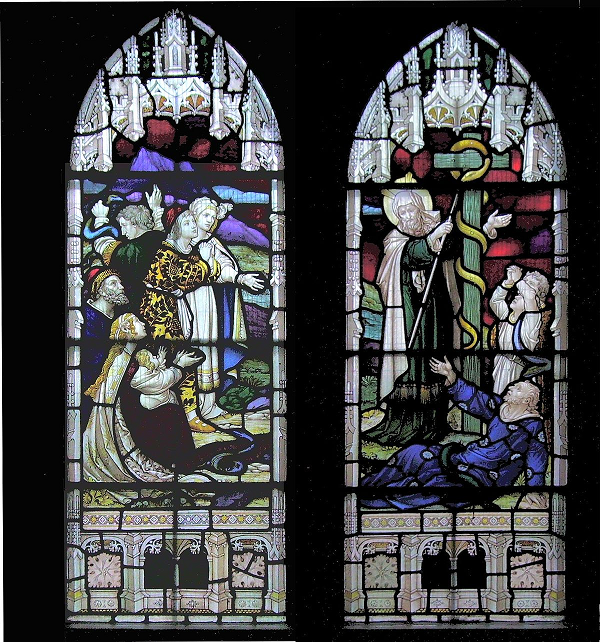
Stained glass depiction of Moses
raising the brasen serpent
Rejoice not thou, whole Palestina, because the rod of him that smote thee is broken: for out of the serpent's root shall come forth a cockatrice, and his fruit shall be a fiery flying serpent.
Isaiah 14:29
The burden of the beasts of the south: into the land of trouble and anguish, from whence come the young and old lion, the viper and fiery flying serpent, they will carry their riches upon the shoulders of young asses, and their treasures upon the bunches of camels, to a people that shall not profit them.
Isaiah 30:6
There are only two mentions of the fiery flying serpents. Like a lot of the mysterious creatures in the Bible, they only appear in the book of Isaiah. The first one coincides with the cockatrice, where it is said that a serpent may beget the venomous cockatrice, and out of that one will produce one that is fiery and flying. It is in context to Judah when king Ahaz dies, and thus a whole burden against Palestinia. The second mention is in Isaiah 30, speaking of the burden of the beasts of the south, where the viper and the fiery flying serpent is mentioned together, as the people of Judah are threatened due to their confidence in Egypt and not the Lord to protect them from Assyria. The Egyptians will not help ultimately.
Non-flying variants are mentioned as 'fiery serpents' in the Old Testament.
And the Lord sent fiery serpents among the people, and they bit the people; and much people of Israel died. Therefore the people came to Moses, and said, We have sinned, for we have spoken against the Lord, and against thee; pray unto the Lord, that he take away the serpents from us. And Moses prayed for the people. And the Lord said unto Moses, Make thee a fiery serpent, and set it upon a pole: and it shall come to pass, that every one that is bitten, when he looketh upon it, shall live.
Numbers 21:6-8
Who led thee through that great and terrible wilderness, wherein were fiery serpents, and scorpions, and drought, where there was no water; who brought thee forth water out of the rock of flint;
Deuteronomy 8:15
Numbers 21 is when the Israelites in the wilderness was punished by the Lord for murmuring often. God sends fiery serpents to bite the people and many died. Moses would create a fiery serpent out of brass on a pole, where anyone who simply looks at it would live. Deuteronomy describes the wilderness where fiery serpents are mentioned alongside scorpions and drought as a place where God would lead them through.

A medieval depiction of the
brasen serpent. Note the draconic features of the serpent, along with
its wings, head crest, and long tail.
The word for fiery serpent by itself is שָׂרָף (saraf), meaning 'burning one'. The flying variants which are the main focus of this article are calledשָׂרָף מְעוֹפֵֽף (saraf m'ofef), the latter part being an active participle of the word עוּף (uf), meaning 'to fly'. The word saraf is also shared with the word seraphim, which are flying celestial beings which are mentioned in Isaiah 6 twice, having six wings where two of them covered their faces, two covered their feet, and two which let them fly. The word can be adjectival in itself. Therefore the word that describes the fiery serpent itself would refer to its burning trait, hence why it is translated as fiery. As for the serpent noun, it comes from Numbers 21:6, its first mention. Saraf is used adjectivally as fiery and in conjunction to נָחָשׁ (nachash), which translates as serpent. The form this word appears in that chapter הַנְּחָשִׁים הַשְּׂרָפִים (hanachashim hasarfim), which means fiery serpents with the definite article and in plural form. It appears every other form of saraf that appears throughout the Bible is derivative of this particular form, as it seems associated with the fact it can bite, and not always the celestial beings referred to in Isaiah 6. Would fiery refer to the potency of its bite or their vibrant colours or something else? The participle m'opheph, which describes its flying ability, shows that this creature was able to fly in a swift manner, much like a bird. The Brown-Driver-Briggs interprets this particular form of the word as 'to fly about, to and fro', and this word is found all throughout the Old Testament, and also translated as brandish when used for a sword.
In the Greek, one will see the word όφις (ophis) used for the serpents mentioned in the Septuagint. Where fiery flying serpents are mentioned in Isaiah 14 and 30, interestingly, both words for snakes differ from each other. Isaiah 14's uses όφις while Isaiah 30 uses άσπίς (aspis), referring to asps, venomous snakes. The latter is probably due to the fact the host verse has what KJV translates as vipers, but the LXX uses asps for that word as well. It is essentially the same thing in any case, as both are supplemented by a modifying adjective πέτομαι (petomai), meaning to fly. It actually appears therefore as όφεις πετόμενοι (opheis petomenoi) and άσπίδων πετομένων (aspidon petomenon), respectively. All it means is 'flying serpent', with one of them having explicit venomous properties. This is also repeated in 1 Corinthians 10:9 in the New Testament which recounts this particular segment of the Old Testament.
Is it a Seraphim?
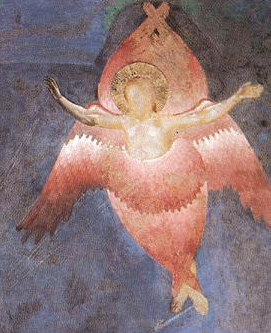
A medieval painting of a seraph,
the burning one. In English, it would be called seraphim, plural as
seraphims. In Hebrew, the plural is seraphim.
The seraph often refers to the fiery angelic beings seen by Isaiah in chapter 6, and are only mentioned by name there. However, they are also brought back in the book of Revelation, albeit not by the same name, but it is clear by their descriptions that it is referring to the same beings.
Above it stood the seraphims: each one had six wings; with twain he covered his face, and with twain he covered his feet, and with twain he did fly. And one cried unto another, and said, Holy, holy, holy, is the Lord of hosts: the whole earth is full of his glory.
Isaiah 6:2-3
And before the throne there was a sea of glass like unto crystal: and in the midst of the throne, and round about the throne, were four beasts full of eyes before and behind. And the first beast was like a lion, and the second beast like a calf, and the third beast had a face as a man, and the fourth beast was like a flying eagle. And the four beasts had each of them six wings about him; and they were full of eyes within: and they rest not day and night, saying, Holy, holy, holy, Lord God Almighty, which was, and is, and is to come.
Revelation 4:6-8
Note the traits are the same, as they both have six wings, and continually say 'Holy, holy, holy', referring to the Lord. What does differ in Isaiah's and John's accounts is that in the case of Isaiah, he was unable to see the faces of the seraphim, as their faces and feet were covered. In the case of John, he was able to see four seraph with faces, one as like a lion, the second like a calf, the third like a man, and the fourth like a flying eagle. There are similar creatures in the beginning of Ezekiel, referred to as the cherub starting from chapter 10, who have four wings and four faces, and although the cherubim too also appear as like burning coals of fire and appearance of lamps (Ezekiel 1:13), they do differ from the seraphim, as the cherubim are mentioned all throughout the Scriptures. Do note the celestial seraphim are referred to as beasts, even displaying attributes like some known beasts and one even having the face of a man, but never as serpents themselves.
Are there commonalities between the fiery serpents and the seraph or is it just in the word itself? It seems the two are distinguished due to the fact the fiery serpent has clear attributes of a serpent, such as their deadly bite (Numbers 21:6), while the seraphim of Isaiah are adorning God's throne and worshipping him, with sentience just like humans (Isaiah 6:7), and it would not be meet for the Lord to use the very serpents which are often representative of a curse. It seems the word saraf itself just means burning, and the fiery serpents since their first mention in Numbers 21 were elliptically referred to as 'burning ones' since. The ones in Isaiah are given the flying adjective. Now, if the two are burning creatures indeed, one wonders if it is just the bite or something else? Usually the venomous traits are clearly translated as such, as one may see in reading about asps or vipers or the cockatrice. Seeing that the celestial seraph are described as burning due to their association with fire, coal, altar, and perhaps like the cherubim, have similar likeness and appearance of fiery brightness, it is possible this fiery adjective may refer to this serpent's bioluminescence, or their body's ability to emit light? Can one find such a creature or is it just fantasy? Or is it merely its bite? Perhaps its colouration?
Fiery Serpent Revisited

The saw-scale viper is thought
to be a candidate for the fiery flying serpent, but it does not fly
When one thinks of serpents, they are long creatures that slither on the ground (Genesis 3:14) while hissing and constricting its victims to death, sometimes with venom or something without, and may possess fangs as well. However, one may never expect such creatures to be flying. Asides from the fact they are put in distinction to normal serpents, let us examine the passages where the fiery serpents do appear in.
And the Lord sent fiery serpents among the people, and they bit the people; and much people of Israel died. Therefore the people came to Moses, and said, We have sinned, for we have spoken against the Lord, and against thee; pray unto the Lord, that he take away the serpents from us. And Moses prayed for the people. And the Lord said unto Moses, Make thee a fiery serpent, and set it upon a pole: and it shall come to pass, that every one that is bitten, when he looketh upon it, shall live.
Numbers 21:6-8
The Hebrews, led by Moses in the wilderness, are around the land of Edom within the Arava Valley, due to the fact they were denied passage through the land and circled around it. They began murmuring against God and against Moses, due to the notion that they had no bread nor water, although they were provided 'light bread' and felt they were not given enough unlike what they may have had in Egypt. The Lord, being angered by this, sent fiery serpents amongst the people, which bit many people that a lot of them died. What is strange is that these fiery serpents were sent to where the Israelites were, which is odd to say the least, considering general snakes are not travellers in packs, nor do they travel long distances, nor are they all that agile. If there were a couple of serpents in the particular nesting area where they were, could the Israelites not have just moved elsewhere? It seems to provoke the question just what exactly was stopping them (asides from God Himself) at dealing with them. Also to see that many of them died by these particular fiery serpents also invites more questions as to how they were not avoided nor killed easily by the many people. What exactly separated the fiery serpents from the usual run-of-the-mill serpent that crawls on its belly? Could they breathe fire like dragons? While that is a possibility, it should be noted the Scriptures say they bit the people.
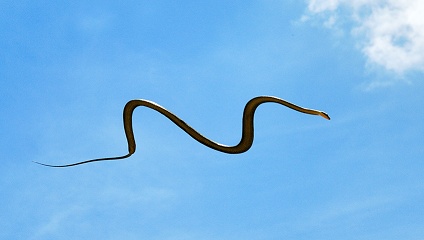
The flying snake of southeast
Asia glides using various motions with its body, but is not largely
venomous nor fiery
If one were to look for a modern analogue to either fiery or flying serpent, one ought to look for either their fiery colouration or their venomous potential and ones especially around the area. In the Arava valley exists a snake called the saw-scale viper, which live around rocky terrain, coloured dark red, and are especially venomous. They seem like a likely candidate all things considered. A Roman account in around 22 AD states that there are snakes also of a dark red colour, a span in length, which spring up as high as a man's waist, and whose bite is incurable.' While the saw-scale viper is endemic to the Arabian peninsula, one cannot help but wonder if they are indeed the fiery serpents of the Bible since none of them fly nor are particularly fiery, and in the end, are just like any other serpents as they crawl on their bellies and do not necessarily travel nimbly outside of their rocky terrain. The closest analogue to a flying serpent are the gliding snakes that live in the jungles of Southeast Asia, but the problem with them is that they do not live anywhere near the Middle East, do not have anything fiery about them other than their mild venom, are coloured green, and their 'flying' is mostly gliding from tree to tree, propelling its body, and not real flight. If not the saw-scale viper, as vipers are also distinguished in Scripture from their fiery or flying counterparts, then what exactly is it?
Historical Anecdotes
Perhaps it may help to read some historical anecdotes of that particular area to see if any fiery or flying serpents are mentioned, as either they do not exist today or are just normal serpents re-imagined. However, it's hard to believe that the Bible itself would make fabrications on its accounts and so one must examine then if there are ancient sources around the region documenting anything like the fiery flying serpents.

A winged serpent of Egypt
representing the Egyptian goddess Eileithya
It does not take long to find that Herodotus, the so-called 'father of history', does indeed have an account of winged serpents in his History Book II.
“There is a place in Arabia, situated very near the city of Buto, to which I went, on hearing of some winged serpents; and when I arrived there, I saw bones and spines of serpents, in such quantities as it would be impossible to describe. The form of the serpent is like that of the water-snake; but he has wings without feathers, and as like as possible to the wings of a bat."
While Herodotus does have some fantastical claims in his Histories, he at the very least has seen in Arabia, where the fiery serpents were recorded to have been in the book of Numbers, winged serpents or bones thereof, reminiscent of dinosaur fossils of varying sizes. He likens it to the water-snake, but that it has wings without feathers, like wings of a bat (like a pterosaur!). We are given a clue as to what kind of creatures these are. Perhaps it isn't the fiery or the flying aspect one has to question, but rather if these creatures are actually snakes themselves or are likened as to snakes instead.
"It is reported, that at the beginning of spring, winged serpents fly from Arabia towards Egypt; but that ibises, a sort of bird, meet them at the pass, and do not allow the serpents to go by, but kill them..."
As described in the cockatrice page, the ibis are well known predators of snakes themselves, which is why they were revered by the locals. This included any snakes, grounded or flying. It seems their natural enemies were the ibises, but at the same time, their wings were not for naught but do allow them to fly. Ibises prevented them from reaching Egypt in large numbers, apparently. Herodotus' third book states further that these flying serpents perch on Arabian spice groves in large numbers. In order to drive them away, workers would throw smoke of storax. They are of various colours and are very poisonous.
"So too if the vipers and the winged serpents of Arabia were born in the natural manner of serpents life would be impossible for men; but as it is, when they copulate, while the male is in the act of procreation and as soon as he has ejaculated his seed, the female seizes him by the neck, and does not let go until she has bitten through. The male dies in the way described, but the female suffers in return for the male the following punishment: avenging their father, the young while they are still within the womb gnaw at their mother and eating through her bowels thus make their way out. "
Herodotus continues to speak of the reproductive trait of these winged serpents. He believes that if they were left unchecked by God and nature, it would be impossible for men to live due to their threatening presence. They are numerous, he reports, but only because they live in Arabia and nowhere else around the world, otherwise having their population checked (even though we see the same flying serpents in Egypt as well). Like the praying mantis, the female consumes the male and from there, instead of being an egg, the offspring would eat itself out of the mother to come out. If true, this sheds some light to Isaiah 14:29's cryptic description of how the fiery flying serpent is born.

Wadjet is an Egyptian snake
goddess, depicted with feathery wings. This is found in King Tut's tomb.
Flavius Joseph, a Jew born from the Roman Empire, records an anecdote regarding Moses as his time as an Egyptian prince leading an army against the Nubians. Whatever one believes about Moses, all we are concerned about in this narrative is about the flying serpents. He states the following in Book II, Chapter X:
…but Moses prevented the enemies, and took and led his army before those enemies were apprised of his attacking them; for he did not march by the river, but by land, where he gave a wonderful demonstration of his sagacity; for when the ground was difficult to be passed over, because of the multitude of serpents, (which it produces in vast numbers, and indeed, is singular in some of those productions, which other countries do not breed, and yet such as are worse than others in power and mischief, and an unusual fierceness of sight, some of which ascend out of the ground unseen, and also fly in the air, and so come upon men at unawares, and do them a mischief,) Moses invented a wonderful stratagem to preserve the army safe, and without hurt; for he made baskets, like unto arks, of sedge, and filled them with ibes, and carried them along with them; which animal is the greatest enemy to serpents imaginable, for they fly from them when they come near them; and as they fly they are caught and devoured by them, as if it were done by the harts;
As one can see, the traits of these particular serpents involve them flying into the air, sneaking up on men unawares. It also shows that their natural predators were the ibises which scare them. The word for serpent is the same as the LXX and the NT's ophis, but there is also έρπετό (erpeto), which means reptile. By equating the snake to reptiles, this implies that the reason why the LXX does not use the 'fiery' adjective for the serpents is because one believed serpents and reptiles were one and alike. There were no names for a flying dinosaur but perhaps due to their relative sizes and other traits, they were more likened to serpents as opposed to dragons, both of which are similar creatures. The Greeks would have only distinguished these particular creatures as 'flying serpents' in comparison to normal serpents or reptiles.
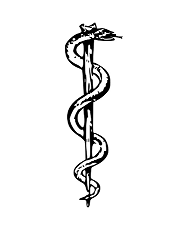
The rod of Asclepius is a universal sign today associated with medical
aid. It seems too similar to the brasen serpent.
These were not the only references to flying serpents. A lot of authors from antiquity mention serpents that fly, such as Aristotle. Pliny the Elder gives a similar depiction of the ibises used by the Egyptians to thwart against the serpents, which come as 'vast multitude of flies', which is a strange habit of normal snakes. The Assyrian ruler Esarhaddon (7th century B.C.) wrote that Arabia was a waterless region full of scorpions and serpents and about flying yellow serpents alongside snakes with deadly breath in his military campaign against Egypt. From these depictions and imagery, it seems very possible that these fiery serpents were not slithering creeping things, but were apt fliers who terrorised the Israelites in those days by air, making it difficult to avoid such beings and causing the Israelites to call upon the Lord so that he may take away the serpents from them.
Nehushtan
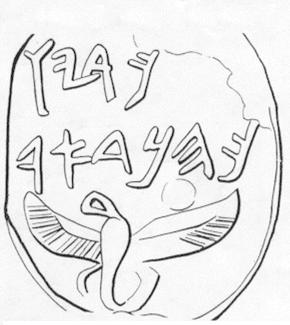
A relief found in Lachish
depicting a winged serpent, perhaps Nehushtan
At the end of the first mention of the fiery serpents which plagued the Israelites, Moses offers deliverance to the Israelites who are suffering from the bites of the fiery serpents, which has killed many. Moses himself was instructed to make a fiery serpent made out of brass and put it on the pole. Many looked upon this fiery serpent and would be healed. This is a good picture of salvation, as the brass serpent would be the picture of Jesus Christ. Salvation is as easy as just looking at the serpent. It did not require people to be willing to repent from their wicked ways nor to do anything special. The serpent was erected, and by trusting the Lord when he said just look at the brass serpent, they may get healed. Why a serpent though? It is because Jesus himself has become sin for us (2 Corinthians 5:21, Galatians 3:13). Christ is divine, but became flesh for us (Philippians 2:5-8, 1 Timothy 3:16). The brass serpent is often portrayed as a curled up serpent in most depictions, but the anecdote has the 'fiery serpent', which is likely a flying creature, should we follow ancient anecdotes about them along with the creatures of Isaiah. Interestingly, being a bronze serpent is reminscent of the yellow colouration as described by Esarhaddon. If we imagine a serpent with bat-like wings, one that is put on top of the rod, it can actually become the shape of a cross just like the one Jesus would die on!
This bronze serpent would later become an idol amongst some of the Israelites, due to the fact that at many times, people want something that is manifest physically and not always know what is spiritual (1 Corinthians 2:14), leading to idolatry. God never intended for the pole with the image of a bronze serpent to be worshipped in itself. It was to picture the coming Christ. The brass serpent was preserved all the way to the times of King Hezekiah, where people would end up worshipping it, which was called Nehushtan (2 Kings 18:4). While northern Israel (Samaria) fell to the Assyrians, Judah was in danger of invasion, and Hezekiah had complete trust in the Lord that he went out of his way to remove idolatry from the high places, brake images, including the brasen serpent that was just to him, a 'thing made of brass' (what Nehushtan means), as this was also causing many to stumble as they were burning incense to it. The people of Israel and Judah often had their shortcomings being influenced by their surrounding nations instead of influencing them, and idolatry was one of their bigger charges. Perhaps if one were to look at other motifs similar to the Nehushtan around the world, there may be some hints as to what it is.
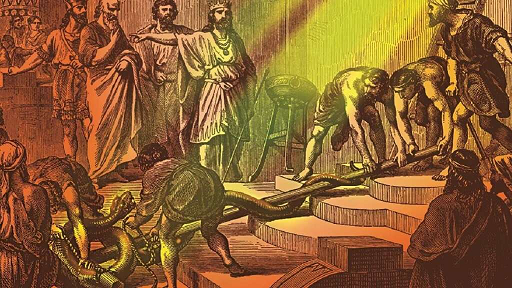
Hezekiah, weary of idolatry,
orders Nehushtan to be destroyed
The rod of Asclepius and the Caduceus of Greek mythology also bear a striking resemblance to the brasen serpent, the former being used in medical contexts, therefore being very likely to be taking the idea from the Scriptural Nehushtan. An excavation of the Lachish area shows that there are multiple depictions of the winged serpent on seals. Due to this idolatry, it is possible that God let such walled cities, including Lachish, to fall to the Assyrians, while Jerusalem was miraculously kept to survive and continue on. The tomb of Sennacherib, the Assyrian monarch who laid a siege on Jerusalem in those same days, also featured a possible depiction of the Nehushtan, a snake with wings, found with Hebrew inscriptions. Winged serpents are a very common motif in Egypt as well. Wadjet, the Egyptian snake goddess, is often depicted as a cobra with bird wings. The word saraph, in fact, is very close to the Egyptian word 'seref', which is a winged snake. It is possible the Hebrews, after living so long in Egypt, have adapted that word into their vernacular and it became part of their own. Tutankhamen's tomb featured a golden throne which has two winged serpents adorning either side of its armrest. Strangely in 1 Chronicles 4:22, amidst the genealogy of many, there is a person named Saraph, who had dominion in Moab, in a place similar to where the Israelites encountered the fiery serpents. Why he bore that name is up to speculation, but it may have ties to the fiery serpents incident. It seems amongst antiquity at least, the flying serpent was a well known motif and may have possibly been based off a reality closer than it seems.
Post Antiquity: Connection with Dragons
After antiquity, there were always more accounts of the flying serpents. Many times, it would coincide with the dragon, as the serpent and dragon are most likely very closely intertwined. In fact, a lot of these serpent traits can easily be thought of as dragons and vice versa. In the first century, a writer Silius Italica wrote of a serpent with rough spots of gold, gliding between the clouds. Lucanus, the poet, would write about the 'chelydrus' amongst other reptiles, whose track smokes as it glides along.
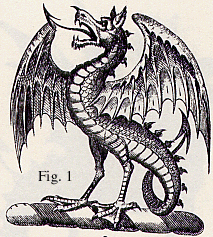
A wyvern is a dragon that has
two legs as opposed to four
In Marie Trevelyan's Folk-lore and Folk-stories in Wales (1909), we see an account of winged serpents. In the same story we also see Trevelyan report that the serpents had a king and a queen amongst them, but the serpent, unlike the ones mentioned by Herodotus, had feathers on it. The men decided to kill the serpents because it was thought that they were hiding treasures. It notably fought by beating its wings on one of the men, but no bite is mentioned.
The woods around Penllyne Castle, Glamorgan, had the reputation of being frequented by winged serpents, and these were the terror of old and young alike. An aged inhabitant of Penllyne, who died a few years ago, said that in his boyhood the winged serpents were described as very beautiful. They were coiled when in repose, and “looked as though they were covered with jewels of all sorts. Some of them had crests sparkling with all the colours of the rainbow.” When disturbed, they glided swiftly, “sparkling all over,” to their hiding places. When angry, they “flew over people’s heads, with outspread wings bright and sometimes with eyes, too, like the feathers in a peacock’s tail.” He said it was “no old story,” invented to “frighten children,” but a real fact. His father and uncles had killed some of them, for they were “as bad as foxes for poultry.” This old man attributed the extinction of winged serpents to the fact that they were “terrors in the farmyards and coverts.” An old woman, whose parents in her early childhood took her to visit Penmark Place, Glamorgan, said she often heard the people talking about the ravages of the winged serpents in that neighbourhood.
The tales of the flying serpents do not stop there either. Even as man has grown more 'rational' with scholastics and other advances of mankind, the tales of great flying serpents still continued on. The polymath Athanasius Kircher, a German Jesuit who was well known for his many skills, writes of a man who has seen an interesting creature flying across a lake in Mundus Subterraneus. He reports it to be a dragon. What is very interesting is that it scatters sparks, as if it was either able to breathe fire or that its body lights up like an angler fish.
On a warm night in 1619, while contemplating the serenity of the heavens, I saw a shining dragon of great size in front of Mt. Pilatus, coming from the opposite side of the lake [or ‘hollow’], a cave that is named Flue [Hogarth-near Lucerne] moving rapidly in an agitated way, seen flying across; It was of a large size, with a long tail, a long neck, a reptile’s head, and ferocious gaping jaws. As it flew it was like iron struck in a forge when pressed together that scatters sparks. At first I thought it was a meteor from what I saw. But after I diligently observed it alone, I understood it was indeed a dragon from the motion of the limbs of the entire body. From the writings of a respected clergyman, in fact a dragon truely exists in nature it is amply established.
Other writings of draconic or flying serpent persisted. Glowing flying creatures were reported by many throughout Europe, including Pliny the Elder, who mentions certain birds that 'shine like fires at night' at a forest in then Germania, which were named Ercinee in medieval bestiaries. A more interesting tale is an encounter of a dragon itself in Rome at 1691. More details of this particular dragon can be found in the dragon page, but eeriely enough, the bone structure which is drawn seems very similar to that of a pterosaur, even before palaeontology was a thing. Medieval interpretation of the fiery serpent was commonly, in fact, venomous serpents of the wilderness. However, a lot of drawings in the medieval times, often featured draconic looking creatures on top of the rod erected by Moses.
Similarities to the cockatrice, owing to its serpentine traits, are mentioned as Samuel Bochart wrote about biblical reptiles, including the flying ones, in his Hierozoocon: sive, de animalibus sacrae scriptura. He writes that how the ancient Hebrews write that the 'flying saraph sets fire to the air, corrupting all that is near it', much like the cockatrice of Alexander Neckam, probably alluding to its venom. It's very likely all the legends of the dragons were conflated ideas of carnivorous dinosaurs, serpents, and perhaps the fiery flying serpent itself. The wyvern, a type of dragon with two legs instead of four, are a common motif in medieval heraldry, and is etymologically linked to Latin 'vipera', meaning viper, asp, or the venomous snake. Due to its wings and other draconian features, it is highly likely that this is also a type of fiery flying serpent. It highly resembles the medieval mythological version of the cockatrice, but is not partially a rooster nor does it have its lore.

Quetzalcoatl of South America is
depicted as a feathered serpent
In the New World, another type of flying serpent exists. In South America, the Quetzalcoatl is the feathered serpent god, also taking a page from the same legend that exists around the world. A pterosaur called Quetzalcoatlus is named after him, featuring an unusually long neck and is one of the largest flying creature fossil ever discovered. In North America, the thunderbird is a popular legendary creature that appears during a thunderstorm and creates lightning. Their traits are varied amongst the many tribes of America, but it is a largely popular idea that this creature is based off of pterosaur of the New World. There are some reports from the native tribes themselves about flying reptiles, including winged snakes. In 1870, a young man of the Crow Indian tribes reported that he encountered a bird which fell, but it was not a bird, but more like a serpent, and had a tail.
Not long after that, in 26 April 1890, an Arizona local newspaper called the Tombstone Epitaph reports of two cowboys who shot down a 'winged dragon' of a very large size, claiming its wingspan was about 160 feet, and a body that was 92 feet long. Although such claims are hard to believe, it is said that the cowboys cut off a part of the wing to prove its existence. Not much is known about it, but whether if this is true or not, the tale of the flying serpent still remains to this day even in the New World as it was popular in the Old World as well. Others around the area and the general wild west of America still claimed that such creatures did exist. The Los Angeles paper in 1890 would state that the same creature was seen about three years before that in Elizabeth Lake. The quest for mankind to go up against their mortal enemy, the serpent, still continues in their hearts. Are there modern discoveries or undertakings where there were efforts to discover if the winged serpents still remain in our day?
The Ropen: Modern Day Pterosaur and other sightings
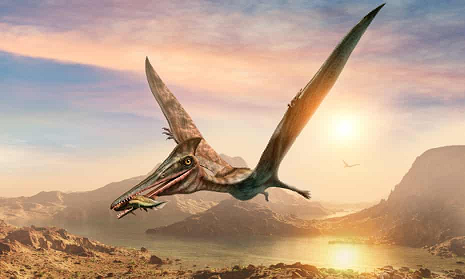
The Pterosaur is a type of
supposedly prehistoric flying animal that fed on fish
In our modern day, there has been a lot of interest in the light of new discoveries, such as dinosaur bones and palaeontology, that led to people seeking to discover perhaps living fossils. Creationists in particular believe that dinosaurs have walked alongside men, as they are mentioned in the Bible, but we find very little existent dinosaurs, if at all, today. The preconceived notion is that they are all extinct since millions of years ago. See the dragon page for further information regarding this topic. One certain expedition was set to find a terrifying beast in the faraway land of Papua New Guinea called the 'ropen', or the 'demon flyer', continuing this tradition of legends or stories that are similar to that of the thunderbird or the flying winged serpents or wyverns and other creatures resembling the pterosaur.
The Papua New Guinea 'ropen' is said to be a rhamphorhynchoid pterosaur (a long-tailed one), which primarily fishes from the sea, has a large leathery skin, a tail that ends with a diamond shape, and most interestingly, possesses bioluminescence, or the ability to glow. Several eyewitnesses from the area, whether they are westerners or the natives, all consistently speak of a creature with pterosaur feature. Whether a person believes that every dinosaurs died out millions of years ago or not are irrelevant to the discussion, as they all allege that there is something in the area. Most eyewitnesses, however, only seem to have seen the 'ropen light' in Umboi Island, as the creature itself is nocturnal, sleeping in the daytime, but feeds at night time, glowing then in an interestingly yellowish light. One of the earliest testimonies of the Ropen is from a WWII pilot named Duane Hodgkinson in 1944, who was stationed in Papua New Guinea. His anecdote states that large bird-like creature flew away from him with a wingspan of about 25 ft. It was dark grey, had a long serpentine neck, beak, and a head crest, sounding a lot like a pterosaur.
There seems to be at least two types of these flying serpents in Papua New Guinea, where a smaller one has a wingspan of about 3-4 feet, while the other is a larger variant. They are said to like the taste of decaying human flesh and are reported to have gone to some funeral gatherings to harass people there, including some western missionaries. One anecdote has a fisherman who was killed by one of these creatures fighting it off, but was seared by the body which seems to have burnt him, adding credence to the 'fiery' part and its bioluminescence. Sadly, there hasn't been any definitive evidence of their existence to the general public so far. Blurry videos, photos, people getting confused with them and perhaps large fruit bats or the frigate bird hasn't really helped the empirical evidence part of the ropen's characteristics. In addition, the same guy, some Mormon named Jonathan Whitcomb, is the only person you'd ever see talking about the creature online, with multiple web domains pertaining to pterosaurs and fiery flying serpents taken by him, and it is difficult to ascertain from just a handful of people how true anything is. There were a couple of expedition towards Papua New Guinea conducted by a person named Paul Nation to find the ropen, but nothing concrete so far. Although there were consistent eyewitnesses regarding a large terrifying flying creature, no real-life sightings has ever taken place other than glowing lights which may possibly be the ropen. Whether it is real or not we leave up the reader to decide and be convinced in his own mind.
To summarise, traits of a ropen are:
- nocturnal creature
- primarily fishes for food
- long tail that ends in a diamond shape, giving a serpent-like physique
- leathery wings that have no visible feathers, so they are flying
- bioluminescence: a body that glows, which makes them fiery

Erskine Kuhn, a soldier stationed in Guantanamo
Bay, drew the pterosaurs he saw outside his barracks.
The Papua New Guinea creature is not the only pterosaur that is reported of today, although it is the most talked about in the field of cryptozoology. The Kongamato of East Africa (overwhelmer of boats) is another candidate for a real life pterosaur. In Guantanamo Bay, a US soldier stationed there, Erskine Kuhn, has seen in 1971, flying across the sea while taking a break from his barracks. His drawing of the two birds that were flying look exactly like some sort of a pterodactyl, complete with its tail, its featherless wings, large beak, and a crest. A Californian woman named Patty Carson reported at 1965 as a child, walking home with her little brother, saw a real live dinosaur very close to her with its mouth wide open, revealing teeth, at Cuba. More reports of pterodactyl sightings continue on even today in all four corners of the earth.
While the ropen is possibly related to the fiery flying serpent, it may or may not be the same Biblical creature, particularly due to the location of said creature being far apart from the Middle East and it is most likely many of these were hunted down by man, seeing them as dangerous. We know that all throughout the world such similar creatures were spotted and many legends were written about it, and it has inspired many myths with dragons and thunderbirds and similar ones around the world. The possibility that real live pterosaurs do, in fact, exist, is an exciting prospect and may lead to more discoveries that will allow us to understand this world which God has created further.
Conclusion: what are these fiery flying serpents?
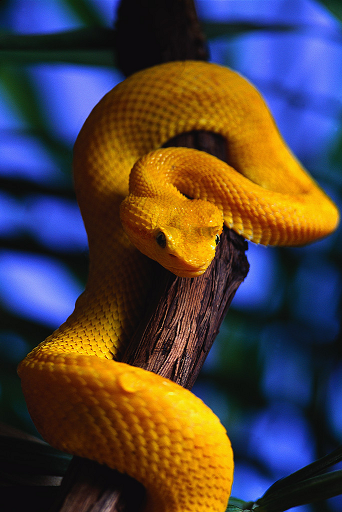
A lot of ancient accounts of fiery serpents were
golden in colouration
Whether one believes that the pterosaur exists in our day or not, it is important to keep an open mind. After all, the coelacanth, a fish long thought to be extinct by this world, were discovered in the coast of South Africa, dubbing it the living fossil. The cultural and historic factors all lead towards something existing in many places of this world, and to not repeat the mistakes of our ancestors, not to esteem that we know everything there is to know now, even if it breaks any preconceived notions of things such as the age of this earth and certain creatures must be extinct from natural causes. If the pterosaur does, in fact, exist in our day and age, and is found to be true, that would further confirm that the word of God is true and it would make our world a much larger place. If not, then it won't have any effect on the word of God anyways, and one can simply see that it's a creature in the past that is (thankfully) now extinct and we can thank our ancestors for hunting most of them down so they no longer plague us. What we should not do is dismiss any claims as spurious just because it goes against one's perceived natural biases on this world (spiritual matters are something else and must be spiritually discerned).
As for me personally, I (the webmaster) believe the fiery flying serpents are some sort of dragons, or at least related to it, and the pterosaur is probably the most logical creature to associate it with. It seems likely to me that the Israelites in that day in the wilderness were punished with agile, terrifying, flying snakes that incited terror and caused many to die rather than the generic serpents which they must have encountered every time anyways. The chain of historical and cultural relevance of the pterosaur further cements my belief of these creatures, and possibly may still exist today. I do not personally believe the ropen or any particular alleged pterosaur species are necessarily the same ones that existed in ancient Middle East, but may be related species. However, like many other mysterious Biblical beasts we have very little idea of, it should not be dogmatic. If I were to be proven wrong, it wouldn't affect my faith in any way and it is just as believable to die by a copious large amount of serpents too, regular or fiery flying. In the end, this is open to interpretation, but one would have to find a way to justify how the creatures in the Bible were distinct from other serpents and were also fiery and flying somehow.
Athanasius
Kircher Mundus Subterraneus
Cryptid
Institute on Winged Snakes
Genesis Park
on the Fiery Flying Serpent
Herodotus
Histories
History's Evidence on Dinosaur and Men
Marie Trevelyan's Account of Flying Serpent
Pliny the Elder's
Natural History
Reports of Pterodactyl Sightings by Jonathan Whitcomb
(PDF)
Back to Top

